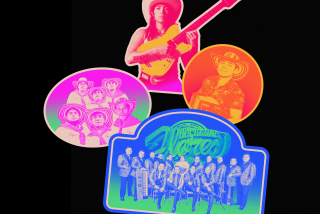Mexico’s Los Ángeles Azules aims to set Coachella fans dancing to cumbia
Over the last 35 years, Mexico’s Los ÁngelesAzules has become one of the country’s top-selling bands using something of a radical strategy: introducing new generations to cumbia, the style of dance music considered as unhip in some corners of the Spanish-speaking world as the polka is here in the U.S.
The group in recent years has added yet another twist to a genre that younger audiences often dismissed as the antiquated music of their parents and grandparents: a hybrid called “cumbia sinfónica” that combines the compelling bounce of cumbia with the expansive sonic possibilities of a symphony orchestra, exemplified in the group’s latest album, “De Plaza en Plaza.”
“It is a grand experiment,” said lead singer and spokesman Erik De la Pena, who joined the six Avante Mejia siblings — Alfredo, Cristina, Elias, Guadalupe, Pepe and Jorge — 18 years ago.
He spoke earlier this month through a translator during an interview from the band’s home in Iztapalapa, Mexico — a borough a few miles south of Mexico City — on a rare break from a typically intensive schedule of shows across Mexico, Central and South America. That itinerary also includes the band’s debut performance later this month at the Goldenvoice-presented Coachella Valley Music and Arts Festival.
They’re slated to perform April 13 and 20, along with a between-weekend slot headlining the Chella Latino music festival with Cuco, Helado Negro and Ocho Ojos on April 19 at the Riverside County Fairgrounds in Indio.
“With cumbia sinfónica, we wanted to demonstrate that music which is more refined, like symphonic music, can be mixed with something popular like cumbia,” De la Pena said. “It’s a way of not putting any brands, any labels on the music, and saying that both audiences can enjoy both kinds of music: the popular and the symphonic.”
Asked whether audiences have totally embraced his band’s take on cumbia by now, De la Pena said, “I don’t want to say we have been fully accepted until we perform. But we are sure we are going to do what we know how to do best. The people will do the rest.”
The booking of Los Ángeles Azules [or the Blue Angels] marks the first time that traditional Mexican music has been on the lineup at Coachella. In previous years indie rock and other Spanish-language acts, including Puerto Rico’s Calle 13, Mexico’s Café Tacuba and Instituto Mexicano del Sonido (the Mexican Institute of Sound) have performed on one of Coachella’s multiple stages.
“I’ve been listening to their music ever since I can remember,” said Rene Contreras, who booked the band for Coachella’s Sonora stage, which largely spotlights Latino music. “I’m Mexican American, and you’d always hear their music at family parties, at backyard parties in the Inland Empire, in L.A. or even in Orange County. It’s stuff my parents played, really iconic cumbia that’s heard all over South America and all Spanish-speaking countries.”
Bringing the group Azules to Coachella, Contreras hopes, “will spark a connection. Coachella has a lot of younger kids [attending] and their parents think it’s a place where people do crazy things, that it’s a giant party. When they find out Los Ángeles Azules are playing, it might be a shock for a lot of parents. They’ll be asking ‘Por que? Por que?’ [Why? Why?] But they have influenced an entire generation and it is great that they have the kind of platform they deserve.”
In addition, Contreras noted that the creation of the Chella show between Coachella weekends will give those parents and others a second chance to catch Los Ángeles Azules, given that Coachella tickets traditionally are snapped up long before the talent lineup is announced.
Although cumbia originated in Colombia, Los Ángeles Azules has found widespread acceptance throughout Mexico by blending that genre’s traditional elements with pulsing rhythms and textures of electronic dance music.
A song such as “Mi Cantar” (My Song), which features Trevi on the album, hints at influences beyond the borders of Mexico, with echoes of Italian film composer Ennio Morricone.

“Mi Nina Mujer” (My Woman), with Mexican American pop duo Ha*Ash, is built on a chord progression and mood typical of 1950s American R&B and doo-wop music.
With its inventive blend of disparate elements, “De Plaza en La Plaza” has sold more than 600,000 copies, constituting double platinum sales status in Mexico, the first album by a Mexican act to hit that threshold in more than 15 years. Guest appearances by a raft of Spanish-language music world stars, among them Gloria Trevi, Natalia Lafourcade, Rodrigo y Gabriela, Pepe Aguilar and Fito Paez, also helped boost the album’s popularity.
Coachella, however, isn’t the band’s first venture to the U.S., or to California. Last summer the group joined the Los Angeles Philharmonic, under Music Director Gustavo Dudamel, for a career high-point performance at the Hollywood Bowl that De la Pena described as “a great, great honor.”

Just as Dudamel has done during his tenure with the orchestra, Los Ángeles Azules has striven to build and strengthen bridges with music. That mission will be all the more timely amid the often polarized debate over U.S.-Mexico relations and the Trump administration’s frequently antagonistic attitude toward immigrants from this country’s southern neighbors.
“With the political climate going on right now,” De la Pena said, “we feel like we’re contributing to breaking those barriers that no one else [but musicians and artists] can break. The human spirit cannot be held back with a simple wall. That has been shown throughout history.”
Rather than muting any sense of celebration the band members might otherwise feel about the compliment of landing a performance slot at Coachella, the political turmoil makes them feel “more inspired — absolutely.”
“We’re all one people, we all live on the same planet,” he said. “When you land in a plane, both the first class and the regular class people all touch down at the same time.”
Follow @RandyLewis2 on Twitter.com
For Classic Rock coverage, join us on Facebook
More to Read
The biggest entertainment stories
Get our big stories about Hollywood, film, television, music, arts, culture and more right in your inbox as soon as they publish.
You may occasionally receive promotional content from the Los Angeles Times.










